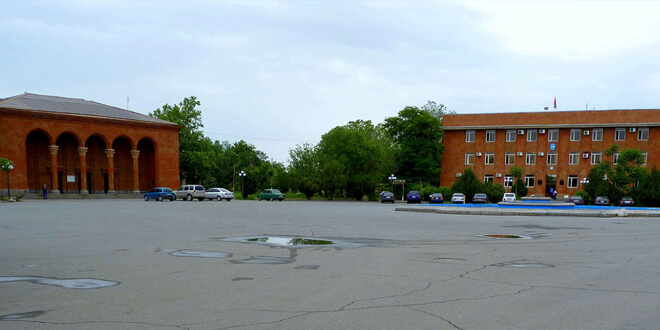Armavir Region


Area: 1,242 km2
Population: 265,770
The area of Armavir province stretches between the mountains Aragats and Ararat and it is a part of Ararat Valley, the biggest and the most fertile of 40 valleys of Armenian upland. Armavir is the smallest marz (region) in Armenia, though the most densely populated province of the country. The administrative center of the region is the city of Armavir.
Historical Sights of Armavir
The most significant site and the pride of the Armavir Region is the religious and spiritual center of the Armenian Apostolic Church - The Mother Cathedral of Holy Etchmiadzin. The monastery was built between 301-303 A. D. by King Trdat III and Gregory the Illuminator (the founder and first patriarch of the Armenian Apostolic Church). Here you can visit St. Echmiadzin monastery complex - a place of pilgrimage and the seat of the Catholicosate of all Armenians.
According to the legend, Saint Gregory the Illuminator had a prophetic vision in which Jesus Christ descended from heaven and with his golden staff pointed to the place where the church was to be built. St. Gregory told the king his dream and in 301 King Trdat III founded Mother See of Holy Etchmiadzin, which is translated from the Armenian language as “the Descent of the Only-Begotten”. The church is one of the oldest in the world. In 1945 the city was renamed after the church - Etchmiatsin.
In the subsequent centuries, Armenians continued creating new religious constructions and monasteries. Other ancient churches in this area are Saint Hripsime church (618), St. Gayane Church (630), and the Church of St. Shokagat constructed in 1634. The monasteries were named after the three virgins who came to Armenia to preach and spread Christianity.
The pagan King Trdat III fell in love with Hripsime for her exceptional beauty but the virgin rejected the king. Trdat ordered to persecute and kill her and the other virgins. Hripsime accepted the martyrdom and the king fell ill after some time. St. Gregory the Illuminator miraculously cured him and Trdat III repented and accepted Christianity.
In 1992, the city officially received back its ancient name "Vagarshaphat", but the majority still uses the name Etchmiadzin. In 2000, the Mother See of Holy Etchmiadzin was included in the UNESCO List of Cultural Heritage. St. Etchmiadzin also houses an extensive museum with relics of special interest like pieces of the crest Jesus Christ was crucified on and a fragment of Noah’s Ark.
The region of Armavir is rich in ancient monuments. Among historic places of interest are the ruins of Argishtikhinili, an Urartu city. On the left bank of the former riverbed of the Araks was the city of Armavir which for centuries was a major economic and cultural center.
A little farther to the west at the confluence of the Araks and the Akhuryan are the ruins of another significant city – Yervandashat – the last capital of the Yervandid dynasty. Two stones bearing Greek inscriptions of the Hellenistic epoch containing historical and literary texts were also discovered in the vicinity of Armavir.
The ruins of the Metsamor Castle are also located in the Armavir region. In the result of excavations carried out in this area more than 22,000 archeological items were discovered.
The territory was once rich with architectural constructions. Ruins of Cyclopean fortresses, burial places, and palace structures have survived from ancient times till nowadays. Arrows from the Urartian period and remnants of an ancient hearth of a heathen tabernacle have been found in the temples of Zvartnots Cathedral and in Ejmiatsin. The ruins of ancient Armavir are near the present administrative center of the region.
The population of Armavir Region
According to the 2011 official census, the population of Armavir consists of 265,770 people. Besides Armenians, Yazidis, Russians, and Kurds also live here.
Armavir

Armavir is the administrative centre of the Armavir region. It is located in the Ararat valley and borders on Turkey. The town was also known as Sardarapat or Hoktemberyan. It is considered to be one of the youngest cities in Armenia. The popular factories of Armenian Wine and Brandy are located here.
The first thing to do in Armavir is to visit the memorial complex of Sardarapat; dedicated to the heroic battle of 1918 against Turks. Then, you can take a walk in the central park of the city where a beautiful church named after Saint Grigor Narekaci is situated.
Here you can also visit the Zoological/Botanical Garden of Armavir. There are lots of cafés, restaurants, and pubs as well, where you can enjoy yourself and try traditional Armenian food.
The area of the present-day city of Armavir is surrounded by ruins of many historical settlements, particularly the ruins of Metsamor Castle, the ancient cities of Armavir, Argishtikhinili, and others.
Thus the present-day Armavir is a small town with a rich historical past. There is a House of Culture in Armavir known as “Red Club”, which hosts the School of Music and Arts and the Dramatic Theatre of Armavir.
City/town
Sights
Echmiadzin
The most important center of Armenian Apostolic Church is The Mother Cathedral of Holy Echmiadzin.This temple was built in the beginning of 4th century, just after Christianity was adopted as a state religion.
Read More



